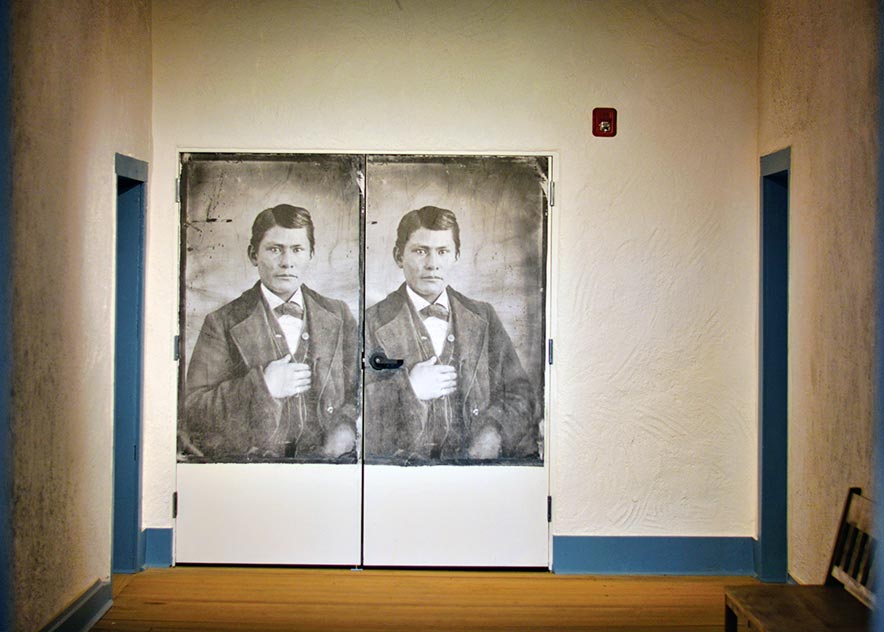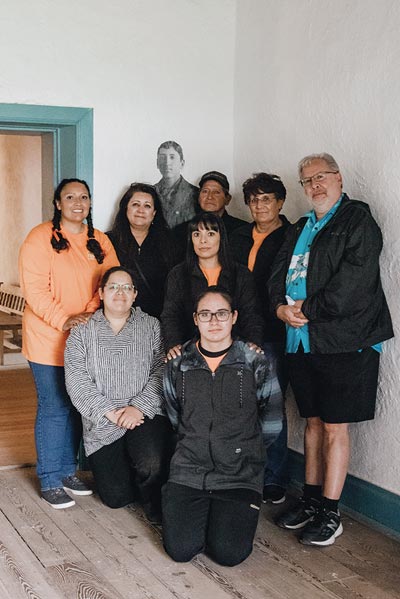
Diné ancestors discovered: Southwest’s dark side uncovered in search for family history

Courtesy photo | Fort Garland Museum and Cultural Center
Juan Carson, an enslaved Navajo youth, appears in the exhibit “Unsilenced: Indigenous Enslavement in Southern Colorado” at the Fort Garland Museum and Cultural Center (June 2021– ongoing).
By Colleen Keane
Special to the Times
ALBUQUERQUE
Happy Girl, ‘At’ééd baa hózhǫ́, and her infant daughter were the only ones in her family who survived a raid along the historic Santa Fe Trail.
Her husband, sons and father were killed.
She was taken to Padre Antonio Martinez’s hacienda in northern New Mexico where her captors bargained with the padre, a prominent Catholic priest, who came from a wealthy family in Taos.
According to oral history, if the raiders – either Native, Spanish or Mexican – weren’t paid, they oftentimes killed their captives.
In the padre’s custody, ‘At’ééd baa hózhǫ́ was baptized and given the name Rosario Romero, wiping out her affiliation to the Navajo Tribe.
The child was named Solidad.
But Rosario and Solidad were not freed. Instead, they were placed in servitude.
Dianne Archuleta

Courtesy photo | Kim Marquez Photography
The descendants of Andres Woodson. On the far right is Gregory Ortega. The youth in the photo on the wall is most likely Andres.
“She wasn’t a willing captive,” said Dianne Archuleta, Rosario’s great-great granddaughter and director of the El Pueblo History Museum in Pueblo, Colorado.
“Rosario’s life was part of an old story in villages throughout New Mexico and the greater Southwest,” added Estevan Rael-Galvez, a former New Mexico state historian who has done research on this subject for more than 30 years as part of his doctoral work, “a story whose telling was perhaps not meant to be passed on.
“It is the story of American Indian slavery,” he said, “an institution that while perhaps obscured certainly existed and through it, thousands of individual lives passed.”
Archuleta said Rosario tried to run away. But every time she did, she was found and brought back to the padre.
Archuleta learned about Rosario, who was around 30 years old when she was enslaved in the mid-19th century, from a book titled “The Enchanted Temples of Taos, My Story of Rosario” by Dora Ortiz Vasquez.
In her research about her great-great-grandmother, Archuleta learned that Rosario was a weaver before her captivity. In servitude, she cleaned, cooked and sewed.
Ronald Rael, an architecture professor at Berkeley University, who grew up in southern Colorado, said the practice of placing indigenous people into servitude was common at the time.
“They were known as criados,” he said, “which meant they were raised by the family as servants.”
Gregory Ortega
Growing up into adulthood, Gregory Ortega from Colorado Springs had an empty place in his life not knowing his heritage.
To fill in the blanks of his family tree, he searched for his great-grandmother, Rita Woodson, on the website, findagrave.com.
There he found that his great-great-great grandfather was Andres Woodson.
“When I looked her up, there were references to his name,” Ortega said.
Then, a PBS special caught his eye, which led him to an exhibit at the Fort Garland Museum and Cultural Center in Costilla County, Colorado – “Unsilenced – Indigenous enslavement in southern Colorado.”
Visiting the exhibit last summer, his family tree began to fill in.
On display at the museum exhibit were listings of 149 indigenous captives from the region.
Ortega’s great-great-great grandfather, Andres, showed up on one of the lists.
“It felt like a gigantic door opening to a powerful heritage,” exclaimed Ortega.
The lists were created by Lafayette Head, a slave owner himself, who was a soldier in the U.S. Army around 1860. He was ordered to document the number of indigenous slaves in Costilla and Conejo counties as part of his military duties.
Rael-Galvez discovered Head’s lists of captives in the national archives during his extensive research on the subject of indigenous slavery.
From his own research, descendant Ortega found out his great-great-great grandfather had been captured by Utes as a child and then sold to a James B. Woodson.
Ortega was saddened by the revelation.
“It feels like our history was erased,” he said. “There was a fracture in the family tree when Andres was sold. There is a grief, an ache, hearing that your ancestors were owned.”
But, Ortega said, Andres wasn’t treated like an indentured servant.
“He was placed in the position of helping run the business, the sheep herding business,” said Ortega.
List of names
The exhibit includes photographs of children and an artistic rendition of the lists of names around the interior adobe walls of the structure that once was a U.S. army post.
“The exhibit combines history and art to make this difficult history accessible,” said Fort Garland Museum Director Eric Carpio. “Our intent is to make community-wide dialogue because in a lot of ways these histories and stories have not been talked about or acknowledged.”
“This exhibit is a beacon that helped me step onto a path in finding this ancestry,” Ortega said. “It has opened a door to learning more about this important family history and powerful culture.
“I will be forever grateful for their work,” he said, “and assistance in facilitating this moment in my life.”
Chip Thomas, a well-known artist and physician, has lived and worked on Navajo lands for decades. He created the artwork for the exhibit as a way to shine a light on the Southwest’s sordid past.
Rael said the inscriptions are a reminder that the lives of the people on the lists mattered and shouldn’t be forgotten.
“Indigenous captive slaves had everything to do with the shaping of this landscape – farming, building churches and homes, the makeup of communities and our DNA,” he said, adding that the majority of the children identified as captives on the lists were Navajo.
Sharing stories
Thomas’s rendition of the lists of slaves is also painted on the outside of Lafayette Head’s ancestral home in Colorado’s Conejos County about an hour away from Fort Garland.
The house, built around 1855, is all that’s left of the sprawling compound, which was once the Ute Indian Agency.
Ronald Rael purchased the building three years ago to protect and share its history.
He said there were stables, a courtyard, a well and a 200-foot porch, most likely the gathering place for distribution of commodities.
Back at Fort Garland, around two dozen descendants including Archuleta and Ortega, gathered together with the staff of the Fort Garland Museum on Sept. 30 for a blessing ceremony featuring a tree planting and the Dineh Tah Navajo Dancers.
Carpio said, “Sean Price, the director of the Dineh Tah Navajo Dancers, reached out to collaborate with the Garland Museum.
“They expressed an interest in creating awareness of (our work) and the spirit of the people impacted by this history,” he said.
“I think it’s important today to acknowledge all of the ways this country evolved on the backs of people,” Archuleta said. “I think it’s important to share those stories.”
Information: historycolorado.org/museums
Jessica Zigmond helped with this story.








 Highway 264,
Highway 264, I-40, WB @ Winslow
I-40, WB @ Winslow